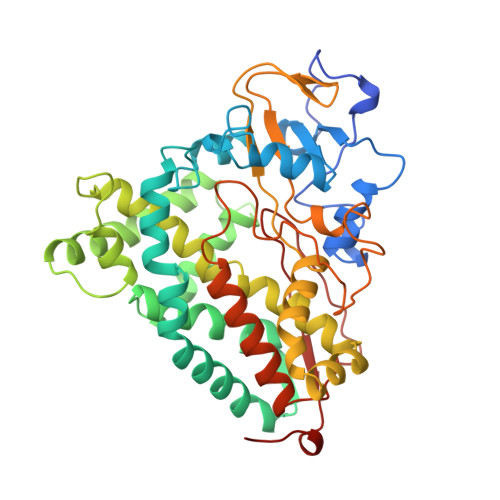Understanding the role of the essential Asp251 in cytochrome p450cam using site-directed mutagenesis, crystallography, and kinetic solvent isotope effect.
Vidakovic, M., Sligar, S.G., Li, H., Poulos, T.L.(1998) Biochemistry 37: 9211-9219
- PubMed: 9649301
- DOI: https://doi.org/10.1021/bi980189f
- Primary Citation of Related Structures:
5CP4, 6CP4 - PubMed Abstract:
Proton transfer in cytochromes P450 is a critical step in the activation of molecular oxygen. Extensive study of the P450cam active site has identified several residues that play a central role in dioxygen bond scission. A highly conserved carboxylate, aspartate-251 in P450cam in the distal helix I, participates in a series of hydrogen-bond/ion pairs near the molecular surface and has been implicated in the catalytic mechanism. Mutation of Asp251 is known to lower activity by 2 orders of magnitude and change the rate-limiting step in the catalytic cycle, suggesting a role for an acid functionality in generation of iron-oxygen reactive intermediates. The turnover rates of the Asp251Asn mutant in various protium-deuterium mixtures have been determined and show a significantly larger kinetic solvent isotope effect, with an overall magnitude of 10 compared to 1.8 for the wild-type P450cam. In addition, a much larger number of protons are involved in the rate-limiting step for the Asp251Asn mutant than in the wild-type enzyme. These results indicate that Asp251 is an essential part of the normal proton delivery machinery required for O-O bond scission. The crystal structure of the Aps251Asn mutant obtained from data collected at cryogenic temperatures has been refined to 1.9 A. Key hydrogen bonds required to hold Asp251 in position have been broken which allows the mutant Asn251 side chain to swing out and away from the O2 binding site leading to a more open active site. This change could allow easier access by water and thus contribute to the observed kinetic solvent isotope effects.
Organizational Affiliation:
Department of Biochemistry, Beckman Institute for Advanced Science and Technology, University of Illinois at Urbana-Champaign 61801, USA.


















